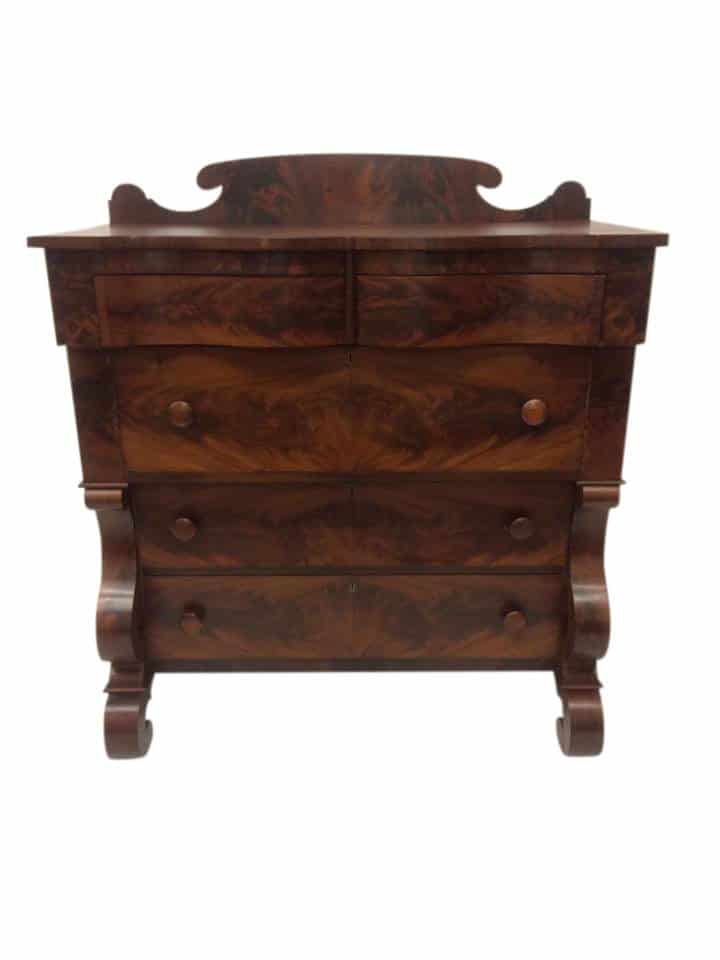
Empire Dressers
Antique Empire dressers make an elegant statement in the home. In addition to being beautiful, empire dressers are extremely useful as an antique piece of furniture.
There are a number of reasons to start collecting empire dressers (often called empire chests), and we’d love to explain to you just a few of the reasons we can’t get enough of this decorating classic!
History of Antique Empire Dressers
The Empire Period, in regards to American furniture, dates to roughly 1825-1850. In this respect, the Empire Period marks the end of the Federal Period and the beginning of the Victorian Period. Empire furniture is bold, grand and completely different from its predecessors. Take a look at this Empire sofa to get an idea.
Empire style in American furniture was heavily influenced by Napoleonic styles in France. However, the American empire furniture, and Empire Dressers in particular, maintained a heavy American flavor. American empire dressers feature native American woods, unique designs and excellent craftsmanship.
Characteristics of American Empire Dressers
Antique empire dressers are immediately recognizable as such. Tell tale signs of Empire dressers include the following:
- Heavy Proportions
- Graduated Drawers (the top drawer is much larger than the bottom drawers)
- Columns or scroll work flanking either side
- Threaded Glass Knobs or Wood knobs are common
- Can feature decorative inlays, veneer work and book veneered fronts
- Claw Feet, Hairy Paw Feet, or Bun Feet are common
- Fine Dovetailing in the drawers indicating excellent craftsmanship
While it is not especially common to see every feature of this list, certainly the heavy proportions are almost ubiquitous in empire dressers. Most empire dressers are chest high, around 45-48 inches in height. Furthermore, they are usually quite deep and girthy.
In this way, we see a reaction to the fineness of Hepplewhite and Sheraton furniture that came before. Gone were the days of tall tapered legs and dainty femininity. Empire dressers, with their masculine profiles and thick columns, seem to stand proudly and unabashedly in a room.
Empire Chest Examples
The other decorative features of empire chests can vary by regional preferences and by maker.
For instance, this plain empire chest with simple turned columns allows the beauty of the wood grain to shine. Notice the top drawer and its mahogany banding, and the incredible swirls of mahogany across the three remaining drawers. A woodworker had to work quite hard to slice and work with veneer for pieces like this. It demonstrates great skill.
Also, the columns are an interesting turned spindle shape. Craftsman often turned a single spindle and then sliced it in half lengthwise to achieve this look. Wooden knobs and bun feet complete the empire dresser.
This more ornate Empire dresser achieves an incredible formal look! The prominent large drawer is offset by three smaller drawers up top. However, it is the incredible carved legs and animal feet that steal the show!
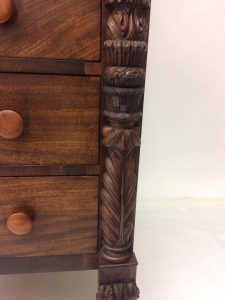
Take a look at the beautifully hand-carved detail on these legs.
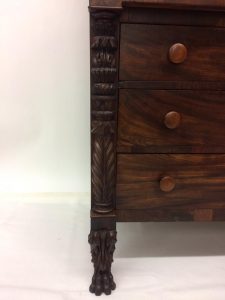
Often called hairy paws, the dressers with this feature often originated in Philadelphia and other urban centers. Craftsmen competed for business, often flaunting their skills. In this way, ornate carvings becoming their calling cards.
A third example of a very different empire chest, brings to light early 19th century tastes. This tiger maple empire dresser differs from the other two. It has scroll “s-shaped” columns on either side, made of cherry. “S-shaped” columns give a very bold, yet toned down look to the empire chest.
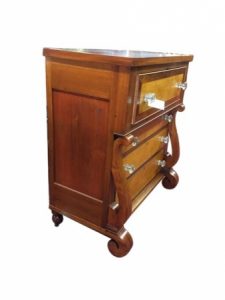
The beautiful mix of tiger maple and cherry takes this empire dresser to the next level. The striped rare tiger grain simply glows in its cherry frame! It is complimented by carved polished glass knobs.
Empire Dressers in the Modern or Historic Home
Empire dressers look smart and stately in many different styles of homes. We particularly like to see empire dressers used in rooms other than the bedroom, for the simple fact that they are so pretty!
Currently, I am looking at a beautiful mahogany empire chest in our entryway. With a mirror or painting above, these stately pieces make great statements in an entryway. The deep drawers make empire chests perfect for stashing winter wear and paper clutter.
In old homes, empire chests are great for dining rooms as well. They act as narrow servers and can be beautifully decorated with china on top.
Empire Dressers and their Unending Usefulness
The deep top drawers of empire chests work great for men and women in the bedroom. Indeed, modern dressers pail in comparison to the tall and hefty drawer space found in an empire dresser. Thick sweaters, jeans and sweatshirts can be stacked high inside. With a bit of wax on the drawer undersides, these nearly two hundred year old chests function every bit as well, if not better, than their modern counterparts.
Empire Style Revivals
In the late 1880’s, empire styles were revived briefly. Brands like Potthast copied the original features of Empire dressers. Oak empire revival furniture also appeared to gain great popularity. Original empire dressers, however, show a greater exuberance. Whether made in cherry, maple, or mahogany, antique empire dressers are a beautiful antique piece to own.
Antique Empire dressers are a staple both in our store and in our lives. In fact, some of the first pieces we bought for our home were empire dressers, and I believe we can count at least four in our home right now. Obviously, they remain some of our most cherished antique furniture, as well as some of the most useful. We love to see and hear how others enjoy their antiques.
If you would like to see all of our antique dressers in stock, please visit the Antique Dressers category.

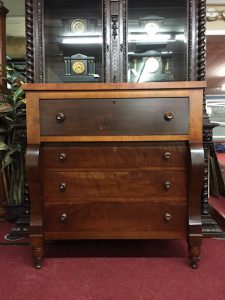
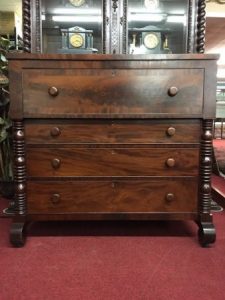
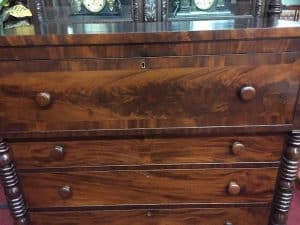
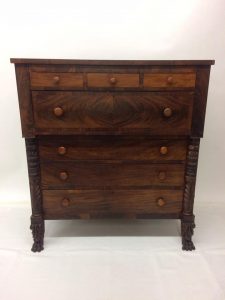
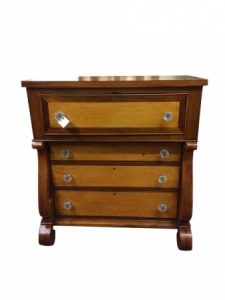
Hello Dawn, Typically curios as you described at auction run between $150 to $450, the range is dependent on condition, condition means everything, every flaw lowers the value. In todays market the look means more than the age. The better decorator look the higher the price, Reconditioned and restored the price may be between $650 to $1200 not seeing yours. The labels are nice and some people love to see them but really do not add any value. The glass being perfect is a plus for sure. I hope that helps.
I recently bought a tiger oak Empire style bowed glass china cabinet I. I’m absolutely in love with it, but I’m having a tough time dating it and finding info on its value. It was manufactured by the Northwestern Furniture Co in Philadelphia for Canton Furniture Co in Baltimore (according to the label o the back). The glass is perfect, and it has all 4 wooden casters. Any info? I have photos I could share.
HI Cynthia. The larger top drawer is common amongst American Empire Chests. However, it is not an absolute rule. Occasionally we will see chests from the period that have similar depth drawers. Of course, European Empire chests have a slightly different look. So, if yours came from England, I might expect it to have a different style. I hope that helps. Thanks for writing!
Hi Sherri! It sounds like a beautiful piece. From what you are describing, it could either be a great late 1800’s reproduction, a 1940’s reproduction or a period 1820-1830 Empire piece. My guess though, based on the dovetailing is that it is a period piece. It might have been refinished at some point, and parts may have been replaced. Take a look at the back of the chest, too. Does it have one solid back piece or tongue and grove back pieces? If it is the later, most likely it is an older piece. Of course, the back planks should show age as well. Hope that helps! Best, Rachel
I just bought an empire dresser that I am trying to date. The dovetailing on the drawers is irregular and thin pin shaped. It has two small drawers on the top, and a larger rolled drawer that locks below those, then three more drawers below that. The wood is beautiful. It just seems to be in too good condition to be that old. But at some point, maybe the drawer bottoms were replaced or maybe it was just lovingly taken care of. I see no maker marks on it at all. Are there any other indications to look for? Thanks for any help!
My mother has left me a very heavy mahogany dresser that she brought over from England with a bunch of antiques in the late 70s. I want to call it Empire but I’m not really sure. I don’t have a photo of the dovetailing of the drawers so I can’t tell by them the age of the piece. The fact that all of the drawers look to be the same size doesn’t fit the usual description of the “large top drawer”. Is that an absolute with empire dressers?
Hi Tara! If you have an Empire Furniture Stamp, this is alluding to the company, not the style. Empire Furniture Company was around from about early 1900’s to 1950s. Here is a great article regarding that company. https://www.vintagefurnitureguide.com/empire-furniture-company/ I would say you should use a mild soap (like Murphy’s Oil Soap) to clean the dresser. Best of luck and thanks for writing!
I purchased a very heavy marked dresser, that I am afraid to clean lol. Hoping you can look at the marking and give me the A-ok to clean this mammoth beast to perfection.
It has an Empire Furniture stamp on the interior of the drawers in green. The handles are made of what appears to be iron and are very heavy. The middle section has two doors that open to 4 smaller drawers.
Thank you so much for any help.
Hi Beverly, Yes, you have to be careful, because there are true Empire chests and then there are Empire Revival Chests. Take a look at the dovetailing. If it shows irregularity, most likely it was made by hand and therefore from the Empire Period (pre 1840). Thanks for reading!
I have a chest that appears to be Empire. I am trying to get a date on it.